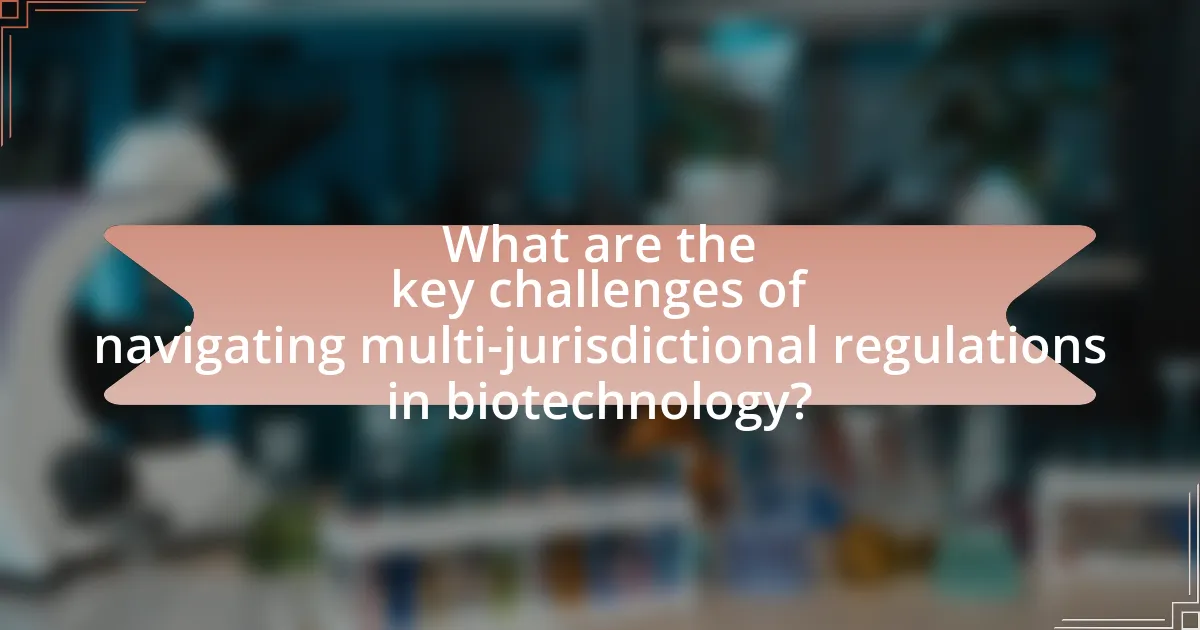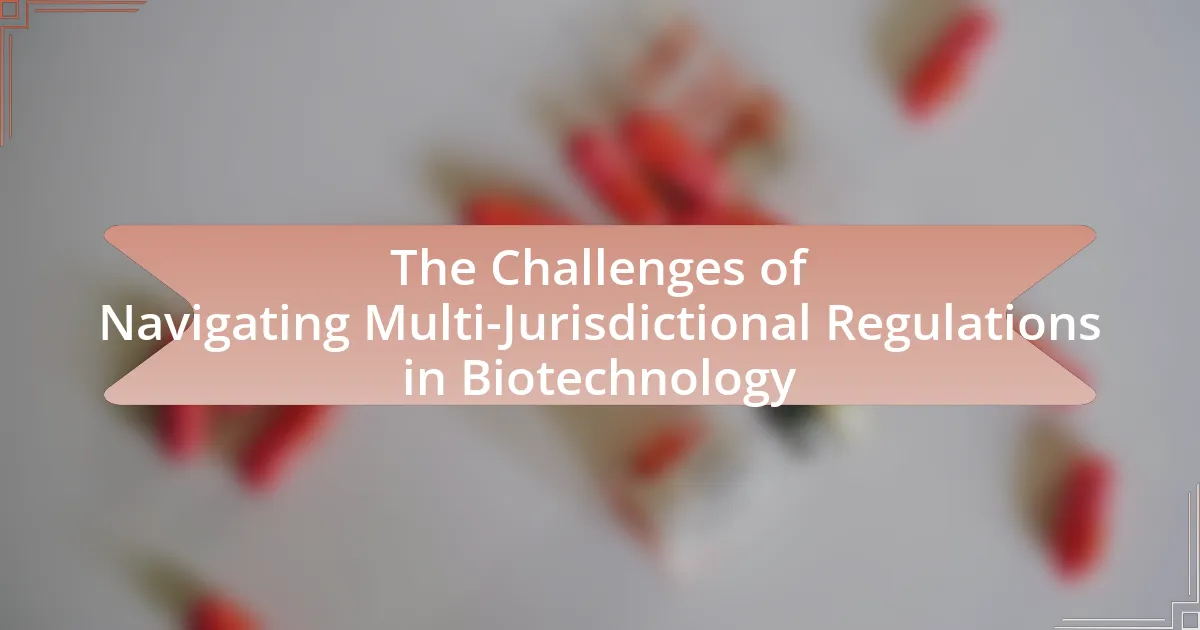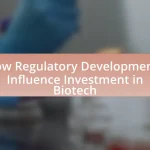The article focuses on the challenges biotechnology companies face when navigating multi-jurisdictional regulations. Key issues include varying regulatory standards, compliance costs, and complex legal frameworks that differ across countries, such as the U.S. Food and Drug Administration (FDA) and the European Medicines Agency (EMA). These discrepancies can lead to delays in product development and market entry, impacting operational efficiency and competitiveness. The article also highlights the importance of compliance to avoid legal penalties and enhance market access, as well as the role of international agreements in promoting regulatory harmonization. Additionally, it discusses strategies for effectively managing regulatory challenges and emerging trends in biotechnology regulations.

What are the key challenges of navigating multi-jurisdictional regulations in biotechnology?
The key challenges of navigating multi-jurisdictional regulations in biotechnology include varying regulatory standards, compliance costs, and the complexity of legal frameworks. Different countries have distinct approval processes, which can lead to delays in product development and market entry. For instance, the U.S. Food and Drug Administration (FDA) and the European Medicines Agency (EMA) have different requirements for clinical trials and product approvals, complicating global strategies for biotechnology firms. Additionally, the financial burden of meeting diverse regulatory requirements can strain resources, particularly for smaller companies. The lack of harmonization in regulations can also create uncertainty, making it difficult for companies to plan and execute their operations effectively.
How do varying regulations impact biotechnology companies?
Varying regulations significantly impact biotechnology companies by creating compliance challenges that can affect operational efficiency and market access. Different jurisdictions impose distinct regulatory requirements for product development, clinical trials, and commercialization, which can lead to increased costs and extended timelines for bringing innovations to market. For instance, the U.S. Food and Drug Administration (FDA) has specific guidelines that differ from those of the European Medicines Agency (EMA), necessitating that companies adapt their strategies to meet diverse standards. This regulatory fragmentation can hinder collaboration and increase the risk of non-compliance, ultimately affecting a company’s competitiveness and ability to innovate.
What specific regulatory differences exist between jurisdictions?
Regulatory differences between jurisdictions in biotechnology include variations in approval processes, safety standards, and intellectual property laws. For instance, the United States Food and Drug Administration (FDA) has a more streamlined process for drug approvals compared to the European Medicines Agency (EMA), which requires additional steps such as the European Union’s centralized authorization procedure. Furthermore, safety standards can differ significantly; the FDA may allow certain substances that the EMA prohibits due to stricter safety assessments. Additionally, intellectual property laws vary, with the U.S. having a “first to invent” system historically, while many other jurisdictions have adopted a “first to file” approach, impacting patent strategies. These differences create challenges for biotechnology companies operating across borders, necessitating tailored compliance strategies for each jurisdiction.
How do these differences affect product development timelines?
Differences in multi-jurisdictional regulations significantly extend product development timelines in biotechnology. Each jurisdiction may have unique regulatory requirements, approval processes, and compliance standards, leading to delays as companies navigate these complexities. For instance, a study by the Biotechnology Innovation Organization found that varying regulatory frameworks can increase the time to market by an average of 12 to 24 months, as companies must adapt their strategies to meet diverse legal expectations. This prolonged timeline can hinder innovation and increase costs, ultimately affecting the competitiveness of biotechnology firms in the global market.
Why is compliance with multi-jurisdictional regulations critical?
Compliance with multi-jurisdictional regulations is critical because it ensures that biotechnology companies operate within the legal frameworks of different regions, thereby avoiding legal penalties and fostering trust with stakeholders. Non-compliance can lead to significant financial repercussions, including fines that can reach millions of dollars, as seen in cases where companies have faced penalties for violating regulations in multiple countries. Furthermore, adherence to these regulations is essential for maintaining product safety and efficacy, which is crucial in the biotechnology sector where public health is at stake. For instance, the European Medicines Agency and the U.S. Food and Drug Administration have distinct regulatory requirements that, if not followed, can result in product recalls or bans, impacting both the company’s reputation and market access.
What are the potential consequences of non-compliance?
The potential consequences of non-compliance with multi-jurisdictional regulations in biotechnology include legal penalties, financial losses, and reputational damage. Legal penalties can manifest as fines or sanctions imposed by regulatory bodies, which can reach millions of dollars depending on the severity of the violation. Financial losses may arise from halted operations, product recalls, or the costs associated with legal defense. Reputational damage can lead to a loss of trust among stakeholders, including investors, partners, and customers, which can have long-term impacts on business viability. For instance, a study by the Biotechnology Innovation Organization highlights that companies facing regulatory non-compliance often experience a significant decline in market share and investor confidence.
How can compliance enhance market access for biotechnology products?
Compliance enhances market access for biotechnology products by ensuring adherence to regulatory standards, which facilitates smoother entry into diverse markets. Regulatory bodies, such as the FDA in the United States and EMA in Europe, require biotechnology products to meet specific safety, efficacy, and quality standards. By complying with these regulations, companies can avoid delays and penalties associated with non-compliance, thereby accelerating the approval process. For instance, a study by the Biotechnology Innovation Organization indicates that companies with robust compliance frameworks experience 30% faster market entry compared to those without. This demonstrates that effective compliance not only mitigates risks but also strategically positions biotechnology products for broader market opportunities.
What role do international agreements play in biotechnology regulations?
International agreements play a crucial role in biotechnology regulations by establishing standardized frameworks that facilitate cooperation among countries. These agreements, such as the Cartagena Protocol on Biosafety, aim to ensure the safe transfer, handling, and use of genetically modified organisms (GMOs) across borders. They provide guidelines that help harmonize national regulations, reducing discrepancies that can arise from differing national policies. For instance, the World Trade Organization’s Agreement on the Application of Sanitary and Phytosanitary Measures sets out rules for food safety and animal and plant health standards, influencing how countries regulate biotechnological products. Such international frameworks are essential for addressing global challenges, promoting trade, and ensuring public safety in biotechnology.
How do treaties and agreements facilitate regulatory harmonization?
Treaties and agreements facilitate regulatory harmonization by establishing common standards and frameworks that member states agree to follow. These legal instruments create a basis for cooperation, enabling countries to align their regulatory practices, which reduces discrepancies and fosters consistency in biotechnology regulations. For instance, the World Trade Organization’s Agreement on Trade-Related Aspects of Intellectual Property Rights (TRIPS) sets minimum standards for intellectual property protection, influencing national laws and promoting uniformity across jurisdictions. This alignment helps mitigate barriers to trade and enhances collaboration in research and development within the biotechnology sector.
What challenges arise from differing interpretations of international regulations?
Differing interpretations of international regulations create significant challenges in biotechnology, primarily leading to compliance issues and legal disputes. For instance, variations in how countries interpret regulations on genetically modified organisms (GMOs) can result in products being approved in one jurisdiction while facing bans in another, complicating market access for biotechnology firms. Additionally, inconsistent regulatory frameworks can hinder collaboration between international research institutions, as differing standards may affect the sharing of data and resources. This fragmentation can also lead to increased costs for companies that must navigate multiple regulatory environments, ultimately stifling innovation and slowing the development of new biotechnological solutions.
How can biotechnology companies effectively manage regulatory challenges?
Biotechnology companies can effectively manage regulatory challenges by implementing a robust compliance strategy that includes continuous monitoring of regulatory changes and engaging with regulatory agencies. This proactive approach allows companies to stay informed about evolving regulations, which is crucial given the dynamic nature of biotechnology regulations across different jurisdictions. For instance, companies that regularly participate in industry forums and maintain open communication with regulatory bodies can better anticipate and adapt to regulatory shifts, thereby minimizing delays in product development and approval processes.
What strategies can be employed to navigate complex regulatory landscapes?
To navigate complex regulatory landscapes, organizations should implement a multi-faceted approach that includes thorough research, stakeholder engagement, and compliance management systems. Conducting comprehensive research on the specific regulations in each jurisdiction allows organizations to understand the legal requirements and potential challenges they may face. Engaging with stakeholders, including regulatory bodies, industry associations, and legal experts, fosters collaboration and provides insights into best practices and emerging trends. Additionally, establishing robust compliance management systems ensures that organizations can monitor regulatory changes and maintain adherence to applicable laws, thereby minimizing risks associated with non-compliance. These strategies are validated by the increasing complexity of regulations in biotechnology, which necessitates proactive measures to ensure successful navigation.
How can companies leverage technology to streamline compliance processes?
Companies can leverage technology to streamline compliance processes by implementing automated compliance management systems that enhance efficiency and accuracy. These systems utilize artificial intelligence and machine learning to monitor regulatory changes across multiple jurisdictions, ensuring that companies remain compliant with evolving laws. For instance, a study by Deloitte found that organizations using automated compliance tools reduced compliance costs by up to 30% and improved response times to regulatory changes by 50%. Additionally, cloud-based platforms facilitate real-time data sharing and collaboration among stakeholders, further simplifying compliance tracking and reporting.
What best practices should companies adopt for regulatory intelligence?
Companies should adopt a proactive approach to regulatory intelligence by implementing continuous monitoring of regulatory changes across jurisdictions. This involves utilizing technology solutions, such as regulatory tracking software, to stay updated on evolving laws and guidelines relevant to biotechnology. For instance, a study by the Regulatory Affairs Professionals Society highlights that organizations leveraging automated tools can reduce compliance risks by up to 30%. Additionally, fostering collaboration between regulatory affairs teams and other departments, such as R&D and legal, enhances the understanding of regulatory impacts on product development and market entry strategies. Regular training and development programs for staff on regulatory requirements further ensure that teams are equipped to navigate complex regulations effectively.
What are the emerging trends in multi-jurisdictional biotechnology regulations?
Emerging trends in multi-jurisdictional biotechnology regulations include increased harmonization of regulatory frameworks, the adoption of risk-based approaches, and enhanced collaboration among regulatory agencies. Regulatory bodies are increasingly working towards aligning their guidelines to facilitate smoother international trade and innovation in biotechnology. For instance, the International Council for Harmonisation of Technical Requirements for Pharmaceuticals for Human Use (ICH) has been instrumental in promoting consistency across jurisdictions. Additionally, a shift towards risk-based regulation allows agencies to prioritize resources on higher-risk products, streamlining the approval process. Enhanced collaboration is evident in initiatives like the Global Harmonization Task Force, which fosters dialogue among regulators to address common challenges. These trends reflect a growing recognition of the need for cohesive regulatory strategies in a globalized biotechnology landscape.
How is the regulatory landscape evolving with advancements in biotechnology?
The regulatory landscape is evolving to accommodate the rapid advancements in biotechnology by implementing more flexible frameworks and adaptive guidelines. Regulatory agencies, such as the FDA and EMA, are increasingly adopting risk-based approaches that prioritize safety while fostering innovation. For instance, the FDA’s 21st Century Cures Act encourages the use of real-world evidence to support regulatory decisions, reflecting a shift towards more dynamic regulatory processes. Additionally, international collaborations, like the International Council for Harmonisation, are working to harmonize regulations across jurisdictions, addressing the complexities of multi-jurisdictional compliance. This evolution is essential to keep pace with the fast-moving biotechnology sector, ensuring that regulations remain relevant and effective.
What future challenges might biotechnology companies face in regulation?
Biotechnology companies may face significant challenges in regulation due to the complexity of multi-jurisdictional frameworks. As these companies operate across various countries, they must navigate differing regulatory standards, which can lead to inconsistencies in compliance and increased operational costs. For instance, the European Union’s stringent regulations on genetically modified organisms (GMOs) contrast sharply with more lenient policies in other regions, complicating market entry strategies. Additionally, evolving public perceptions and ethical considerations surrounding biotechnology can prompt regulatory changes, requiring companies to adapt swiftly to maintain compliance. The rapid pace of technological advancement in biotechnology also poses a challenge, as existing regulations may lag behind innovations, creating uncertainty in the approval processes.
What practical tips can biotechnology companies follow to navigate regulations successfully?
Biotechnology companies can successfully navigate regulations by implementing a comprehensive compliance strategy that includes understanding local and international regulatory frameworks. This involves staying informed about the specific requirements of agencies such as the FDA in the United States and EMA in Europe, which govern biotechnology products. Companies should establish a dedicated regulatory affairs team to monitor changes in legislation and ensure that all products meet safety and efficacy standards. Additionally, engaging with regulatory bodies early in the product development process can facilitate smoother approvals. Regular training for staff on compliance issues and maintaining thorough documentation of all processes further supports adherence to regulations. These practices are essential, as non-compliance can lead to significant delays and financial penalties, underscoring the importance of a proactive approach in the highly regulated biotechnology sector.


